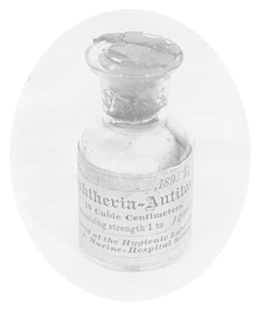Diphtheria is a contagious disease caused by Coryne-bacterium diphtheriae, a bacteria found in the mouth, nose, and throat of an infected person. An infection begins with a mild sore throat, a low-grade fever, neck swelling. The symptoms progress to nausea, vomiting, chills, and headache.
A gray, tough, fibrinous membrane is found stuck on the throat and tonsils. Sometimes it's so tightly stuck that removing it causes bleeding.
Complications typical of a diphtheria infection include pneumonia, swelling of the breathing tubes so severe that breathing is compromised, and respiratory failure. The child may have irregularities in the heart beat and even heart failure. Sometimes the heart itself can become infected--a condition called myocarditis.
Prevention is the best treatment. Proper immunizations eliminate the chances of coming down with diphtheria.
A person infected with diphtheria is contagious for two to four weeks. Once the diagnosis is made, the treatment begins with shots of an antitoxin. Antibiotics are an important part of the treatment. Even with adequate treatment, five to ten percent of those who become infected die.
Tetanus, also known as lockjaw, is caused by the bacteria Clostridium tetani. It enters the body through an open wound such as a cut, puncture wound, or a burn. An infection may occur after what seems like a trivial or even unapparent injury.
The bacteria, which is usually found in soil and manure. produces a toxin that can spread throughout the body. It enters the nerves and may cause painful tightening of the muscles, usually all over the body. The symptoms of tetanus include lockjaw, stiffness in the neck and abdomen, difficulty swallowing, fever, elevated blood pressure, and severe muscle spams.
Every year over 50,000 people worldwide die from tetanus. In the United States, there are about 100 cases of tetanus reported to the CDC each year. The vast majority of cases occur in unimmunized individuals or those whose last immunization was over 10 years ago.
As with any disease, the best treatment is prevention. The DTaP shot is very effective. The treatment for a person with tetanus is making sure their airway remains open so their breathing is normal. Human immune serum globulin is given to prevent the formation of new toxin. IV fluids are often needed as is sedation to lessen the muscle spasms. With proper treatment that's begun early, the chances of survival are good.
COPYRIGHT 2004 Pediatrics for Parents, Inc.
COPYRIGHT 2005 Gale Group



